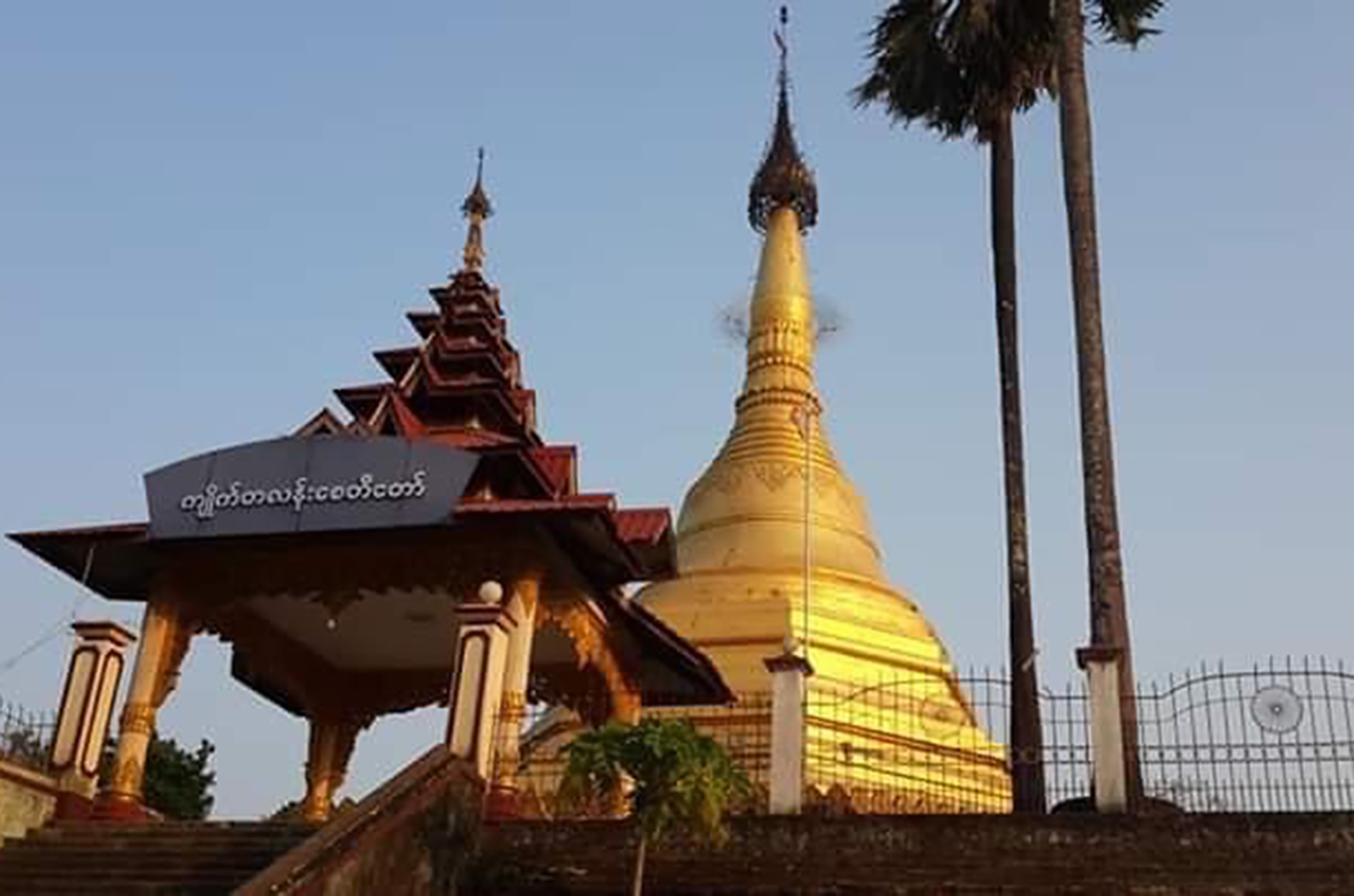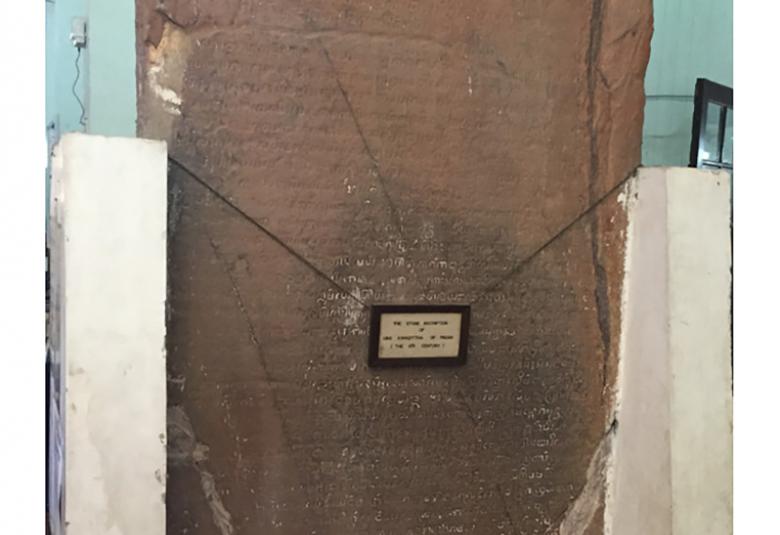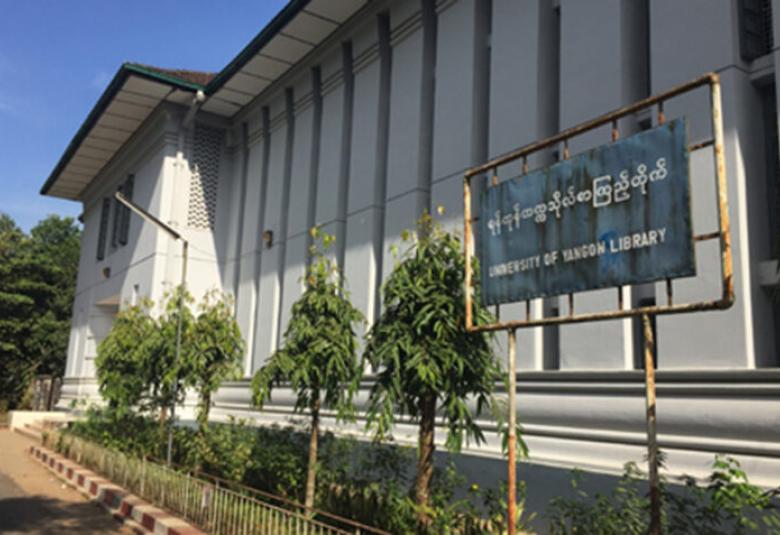Dr Aung Myint Oo
As a visitor enters the campus of University of Yangon, and walks along the Chancellor Road, before he (or she) reaches the Convocation Hall, close to the Thit-pok, the massive Tetramelaceae hardwood tree, the University of Yangon Library is there on the right side of the road, a well- known treasure house of knowledge and learning. Many a time have many a scholar, engaged in academic pursuits related in some way or other with University of Yangon, visited this precious resource centre; however, not many have discovered the rare existence of the genuine ancient heritage of King Kyansittha of Bagan Period, housed in this modern building. This might lead the reader to ponder over the relationship between University of Yangon and King Kyansittha. It was a short while after University of Rangoon (University of Yangon) was established that this ancient heritage was brought to University of Rangoon Library for the sake of the preservation of Myanmar culture. This historic heritage, which dates back to the 11th century, marking the reign of King Kyansittha, now remains through the life span of nearly one thousand years. It now stands in University of Yangon Library as an invaluable part of the history of University of Yangon.
What is that ancient heritage of King Kyansittha preserved in University of Yangon Library? How did it find way into this house of knowledge? What historical values and essence have been immortalized in it? As a visitor entering the Library, he may be attracted by a huge stone inscription, erected on a cement base, next to the Loan Section on the right side of the entrance. It is over seven feet high and over three feet in breadth. There it stands tall and heavy but many might have failed to notice its existence.
If the visitor takes a close look at the inscription, first he will see a small label reading, “THE STONE INSCRIPTION OF KING KYANSITTHA OF PAGAN (THE 11th CENTURY)”. Though this ancient column dates back to nearly one thousand years ago, it has remained intact, housed inside the Library, free from winds and weather through time and changes. Thanks to the Library, many characters have remained free from damage. Though resembling the ancient Myanmar characters, it is rather hard to decipher what the inscription reads. Because the history of this stone inscription has remained unknown, and the meaning of the lines unfathomed, many visitors to the Library have failed to turn to their curious eye to this stone inscription.
A close study will reveal that this stone inscription has remained a genuine artefact of ancient heritage. Moreover, it would be of scholarly interest to make a trace of its arrival to this Library. Before the label was hung on it, reading it had been the work of King Kyansittha, this stone inscription had remained a brains-racking riddle for some time. During the colonial period, before University of Rangoon (University of Yangon) was established, it was displayed at Phayre Museum, Yangon, which was attached to the Zoological Gardens, which was located in the present site of Yangon General Hospital. Since the British colonists were avid collectors of artefacts of ancient heritage, as soon as they had occupied the whole country, they began the collection of the ancient artefacts of Myanmar culture from all over the country, and had them on display in Phayre Museum. The ancient stone inscription of King Kyansittha was brought from one part of the country and had for some time been on display in the Museum.
However, though the inscription gave an impression of ancient writing, nobody was able to decipher its meaning until the ancient Pyu and Mon expert Dr C.O. Blagden of the School of Oriental Studies, London University took the task of deciphering. He was a great scholar who taught ancient Phyu and Mon language to Sayagyi U Pe Maung Tin, who had come to England on scholarship programme and who would later be the first Myanmar principal of University College, University of Rangoon. Dr Blagden, who had never been to Burma (Myanmar), perusing the ink impressions of the inscription, identified the text as one written in ancient Mon, and gave his deciphering of its content, which appeared in print with the photographs of the ink impressions in Volume (1), Part (2) of Epigraphia Burmanica, published in 1920.
Dr Blagden was successful in deciphering the sources of the characters of the epigraph and its content, but the original location of the pillar remained unresolved: to use his own terms, ” The original location of this record is unknown to me.” But with reference to Line 47 reading “Ceti kyauk-talin”, the possible original location could be that of a pagoda in the region of the Mons in Lower Myanmar, but no exact location was identified.
In 1930s, the Zoological Gardens, formerly situated at the present site of Yangon General Hospital, was moved to the present site of Yangon Zoological Gardens, and the Phayre Museum, attached to the Zoological Gardens, was disbanded. The inscription pillar was temporarily kept at the Secretariat Yangon. In 1933, the authorities of the University of Rangoon moved the pillar to University of Rangoon Library, the transportation charges being paid by the University. However, since its original location had remained unresolved, it carried the label: Place of Origin Unknown. The scholar who first revealed the clue of the original location of the inscription, now already finding a new home in University of Rangoon Library, was Sayagyi U Pe Maung Tin (1888-1973), the principal of University College, University of Rangoon (University of Yangon), who may be regarded as the founder of the future Department of Myanmar Language and Literature. During the April vacation in 1963, he made a study tour around the Kelasa Mountain, assumed to have been Thahton, the seat of ancient Suvarnabhumi Empire. On his visit to Ayetthema (“The Weaver Woman”) Village, he had interviews with the local elderly people, and from these interviews, learned that about fifty years ago (around 1886), the authorities of the British government made an excavation of a huge inscription pillar, inscribed in ancient Mon characters, at the Kyaik-ta-Lan (the present Mya Thein Tan Pagoda), located at the foot of the Kelasa near the village. The pillar was carried aboard a barge, towed by a ship. A villager happened to visit Yangon and, on his return, informed the other local people that he had seen the long-lost inscription pillar there at the Zoological Gardens. This new finding was reported in the article, “A Mon Inscription by Kyanzittha at Ayetthema Hill” in the Journal of the Burma Research Society (JBRS) (Vol. 28, Part 1), published in 1938.
On making a trace of the location of the inscription pillar, Sayagyi U Pe Maung Tin made a reference to the Government Archaeologist Taw Sein Ko’s record named Archaeological Tour Through Ramannadesa, which appeared in print in Indian Antiquary, December Issue, 1981. It was mentioned on Page 7 in this research article that an ancient inscription pillar excavated near Ayetthema Village about eight years ago was brought to Phayre Museum, Yangon. According to the interviews with the local people of Ayetthema Village and the missing link of the Superintendent of the Archaeological Survey Taw Sein Ko, Sayagyi U Pe Maung Tin confirmed his research finding that the origin of location of the inscription, which was moved from Phayre Museum to Yangon University Library, was the Kyaik Ta Lan Pagoda near the Ayetthema Village at the foot of the Kelasa Mountain in the region of the Mons.
Ayetthema (“Yet Kan The Ma”) Village, being the original location of the ancient inscription, now housed in University of Yangon Library, is located at the foot of the Kelasa Mountain, Taung Sun Village Group, Bee Lin Township in the Mon State. The Kyaik Ta Lan Pagoda as referred to in the inscription is located on the Veponla Hill to the west of Ayetthema Village. On this hill, which descends from the slope of the Kelasa Mountain, stands the Kyaik Ta Lan Pagoda (the present Mya Thein Tan Pagoda), renovated by King Kyansittha since Bagan Period through the successive periods.
King Kyansittha, having succeeded to the throne in the ancient capital of Bagan in M.E 446 (AD 1084), toured the various regions to found the Bagan Empire. On arriving at the site of the Kelasa in Ramanya Region, he found the ruined Kyaik Ta Lan Pagoda and renovated it as a deed of merit. The pagoda, which was already ruined at the time of King Kyansittha’s discovery, must have been a very ancient pagoda. After having renovated the pagoda, the pious king made a record of his deed of merit in the form of a Mon inscription.
The Inscription carried the date of inscribing, which reads: Friday, 13th of the waxing of Kason, M.E 460 (Friday, 16th April, AD 1098). So its life span is already over 922 years. The exact date of inscribing the inscription may be regarded as making a great contribution to the study of the history of literature and culture. It is an artefact of ancient heritage dating over 820 years if compared with the centenary of University of Yangon, which falls on 1 December 2020.
During his reign, King Kyansittha was considered to be a great monarch who made utmost efforts to promoting friendship and unity among the nationalities, carrying out the nation building tasks and consolidating the expanding Union. He made tours all over the country and performed nation building tasks, and had the record of his great deeds of merit inscribed in Mon language. The Mya Kan Lake and the Alan Bagan Lake were dug in Bagan, and the Mya Kan Mon Inscription and the Alan Bagan Mon Inscription were erected. After the Kyaik Ta Lan Pagoda of Thahton had been renovated, the Kyaik Ta Lan Mon Inscription was erected. After the renovation of the Kyaik Tè Pagoda at A-Lu Village, Thahton, not far from the Kyaik Ta Lan Pagoda,had been made, the Kyaik Tè Mon Inscription was erected. The Shwezigon Mon Inscription and the Shwesantaw Mon Inscription of Pye are now well known as those carrying a historic record of King Kyansittha, who had unfailingly fulfilled the needs of his people.
It may be noted that the characters of Myanmar language had not yet been fully been developed at the time King Kyansittha did inscribing in the Mon language. The phrase Let swè khi ye ( the water from the Let Swè Chi Lake) that was mentioned in the Mya Kan Mon Inscription was considered as marking the earliest evidence of Myanmar language. Hence, the Mon inscriptions of King Kyansittha may well be regarded as serving as the models for developing the characters of the Myanmar language. Moreover, these inscriptions also marked the efforts of King Kyansittha in building the love and friendship between the Mon and the Myanmar people. So scholars studying the trend of the development of the writing system in Myanmar language, as well as the rise and development of Myanmar culture and history must not ignore the Mon inscriptions of the great king.
It was when, during the colonial period, the Phayre Museum was disbanded that the Mon inscription pillar of King Kyansittha was moved from there by the far-sighted authorities of University of Rangoon at the expense of their own to the university campus. Here, in the university campus, this heritage of literature and culture, symbolic of love and understanding among our nationalities, was given most proper space as its new home inside the University of Rangoon Library, the treasure house of knowledge. Many other inscriptions of historic values have suffered damage due to the ravages of wars, winds and weather, but very fortunately, this inscription pillar has stood intact, housed safe and secure in the University of Yangon Library.
Primary sources are highly valued in doing research in the field of various disciplines. It is quite an invaluable asset to get access to the primary source of about one thousand years ago for the study of literature, culture and history of a nation. But such a source, located in University of Yangon Library, is within our reach. Scholars from abroad, who were invited to visit the Library, as they passed the entrance, were shown this massive inscription pillar, and when given an explanation that this is the evidence of ancient writing of about one thousand years ago to the credit of our country, they were all were filled with awe, and were very much impressed in observing this ancient inscription.
The presence of such a precious ancient heritage in the university campus is indeed a great pride to the university staff and students of University of Yangon as well as scholars engaged in doing research in collaboration with the University. Not only students studying higher education in University of Yangon but also those visiting the campus may not miss the chance of observing this inscription of great historical value. Therefore, on the occasion of the centennial celebration of University of Yangon, you all are invited to come and visit the University of Yangon Library, where you can observe the ancient inscription of the life span of nearly one thousand years, which is King Kyansittha’s ancient heritage.
(Translated by Dr Zaw Tun)




